On The Way West.
12



12
|
The photo I m referring to was in a book about Alpine Tunnel that was written by a friend of Dow Helmers.
|
|
Can you share the image? I don't know that I've seen it and if it's conclusively showing a wye prior to 1903 that would be very interesting.
Dave Eggleston
Seattle, WA |
|
Hey Dave,
Like you, I'm skeptical of much of the "conventional wisdom" concerning Hancock. But never the existence of a wye located just upgrade of the water tank, even early on c.1881-82. Can you state the reasons for your skepticism?? FWIW, here is an early, undated photo, take from the Hancock water tank, looking down toward the bridge over the creek. Both legs of a wye are visible, the tail track at the left frame. 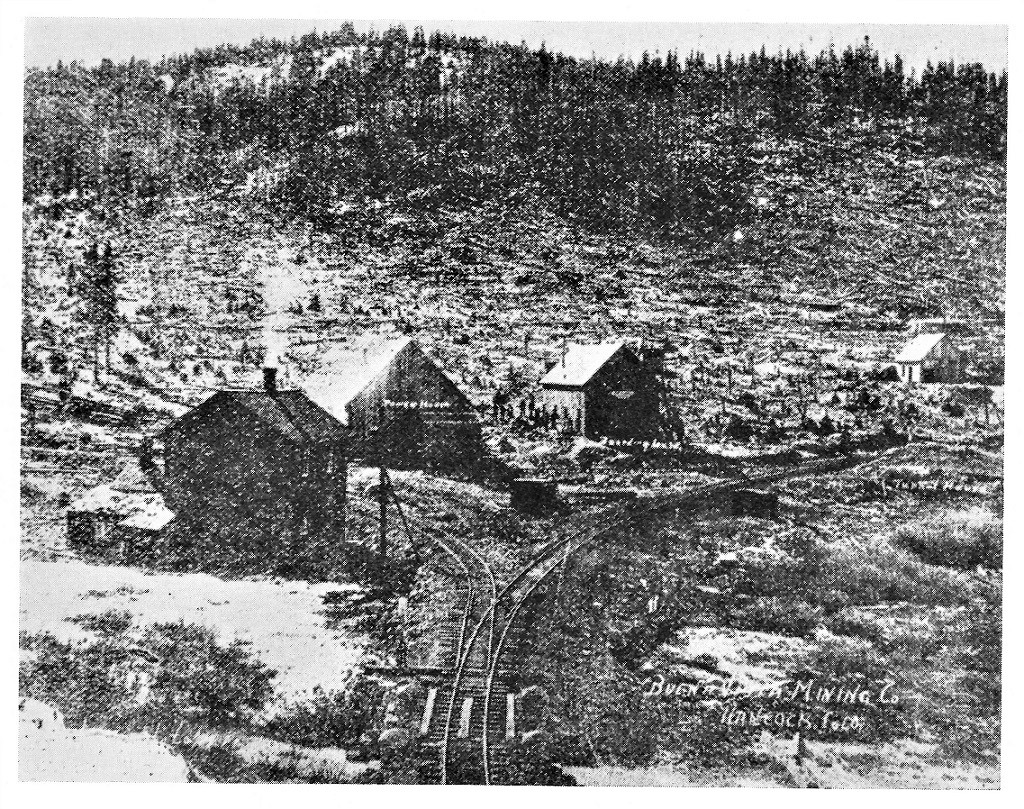 In Digerness, Mineral Belt II Perhaps Chris Walker, who's memorized the name of every mine in Colorado, can help date the photo of the Buena Vista Mining Co. 
Jim Courtney
Poulsbo, WA |
|
Jim,
My Digerness books (heck almost all my South Park books) are packed away thanks to a home remodel. Does that photo show an actual date in the written inscription on the lower right corner? Knowing the date of the BV company may help. My skepticism on Hancock's wye arises from several, arguably none of them definitive, data points. This is a problem I've been stuck on for a long time--the wye seemed reasonable but something just doesn't feel right. I want definitive evidence there was a wye prior to 1903, but I can't find--or have missed (it happens)--any evidence there was. Mea culpa if I've missed something in plain sight! The wye at Hancock would seem to serve one of a few needs: helper engine turning, rotary plow turning, winter closure train movements (if trains ran to Hancock during those periods). Here are the things that made me move away from the "wye at Hancock" crowd: 1) The lack of mention of the wye on employee timetables from 1884 and 1889 is the main data point against a wye. They are shown at Schwanders, Hortense, Pitkin, and Gunnison. And there is no question they were at those places. Was there a wye during tunnel construction days that was decommissioned? Ultimately, why isn't a Hancock wye on the timetable? 2) Some interpretations of early operations on the district have been discussed over the years here and on the DSP&P Yahoo group--there is some evidence in early days (and even under the C&S) that helpers weren't broken off at Hancock--and even if they were they tended to run to at least St. Elmo, even Como. This was argued around the existence and non-use of a turntable at the Tunnel in the 1880s and 1890s but I'd apply the same thinking to Hancock. Operations on the division between Gunnison and Como quickly became basically a coal unit train operation--most other promised traffic did not pan out. Lots of helpers eastbound, but the open question is: Do we have a document laying out helper operation at that time? I haven't seen it. We assume they'd turn at Hancock but did 1890s dispatchers think this way? 3) The presence of a turntable at St. Elmo placed in 1885 and lasting at least into the 1890s, depending on your thoughts on the Alpine Tunnel engine house turntable situation. St. Elmo was the official end of track when the tunnel was shut down, not Hancock and engines were turned there in the winter closures and likely all year. Sure, some operations ran to Romley and maybe even Hancock during the closures, but it appears that they backed down to St. Elmo. Same with Pitkin at the west end during the winter. So, was a wye necessary at Hancock? 4) Reading up on the justification for the wye at Hancock in 1903 in the Documentary history series leads me to believe there wasn't an existing roadbed from an earlier wye at that location. That was a head-scratcher: Shouldn't there have been grade that could be exploited? Side note: all the justification laid out in 1903 seems exactly what would have justified a wye earlier, but the 1903 correspondence and responses feel like "Hadn't anybody thought about this before?" 5) Hancock's agency was closed and the depot moved in 1887, reflecting the dropping off of the station's importance economically and tilting to Romley/St. Elmo. This doesn't mean helpers didn't use the place but at least in the 19th century I could see not having turning facilities as being not a critical problem in the mind of management. In fact I don't think carded meets ever happened at Hancock, either. 6) The rotary didn't arrive until 1889 so a wye for turning that beast wasn't initially of any concern, technically not until 1896 because of the extended tunnel closure. Almost every other winter saw 4-7 months of tunnel closures, from 1885 to 1910. Sure there were exceptions, but those were rare years. So turning a rotary wasn't a consideration until 1890 and then not again until 1896. I dunno, it just feels like there's enough to question the prevailing "there was a wye" thinking so as a researcher I default to "bring the data." What have I missed that is definitive and tied to a date?
Dave Eggleston
Seattle, WA |
|
This post was updated on .
In reply to this post by Jim Courtney
Out of curiosity, I did a search in the newspapers on the name "Buena Vista Mining Company." There was a company presumably holding mines all over Colorado in 1880 under that name, but I've found no mention of Hancock properties. A company of that name pops up in 1892 but again no references to Hancock mines.
Then February 9 1904 the Aspen Times reports: 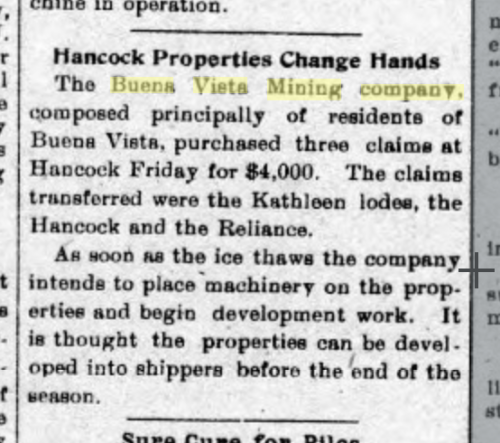 April 27 1904 Aspen Daily Times: 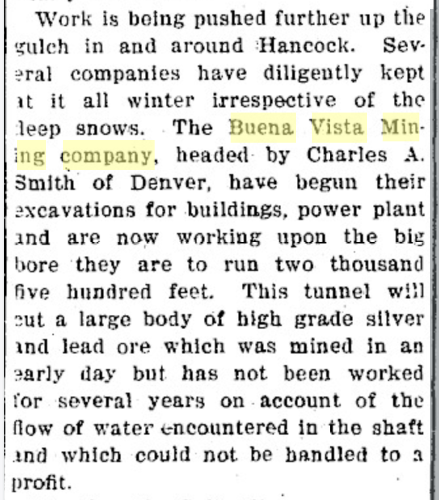 December 8 1904 Colorado Republican: 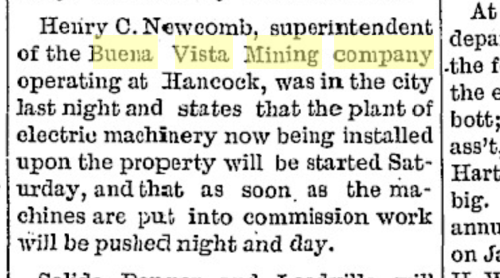 <edit> I just found a reference to the company in the 1904 Mining Industry and Review V46 p616: "The Buena Vista Mining Company have fourteen claims in the west edge of Hancock. They now have a tunnel of 115 feet and expect to cut a rich vein in twenty-five feet more, which was located by surface development. Their ore assays are about eighteen ounces silver and one-half ounce gold. They expect to install a compressor and drill immediately." August 24 1905 Colorado Republican:  May 29 1906 Salida Mail: 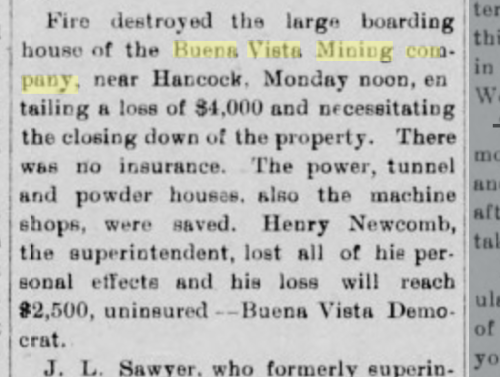 The above search was definitely quick but provides a further toehold in the argument against the wye at Hancock prior to 1903 by casting doubt on a Buena Vista Mining Company located in Hancock before 1904. It suggests deeper research to prove otherwise but currently leaves open doubt and with that I have to question the presence of a wye at Hancock before 1903.
Dave Eggleston
Seattle, WA |
Re: On The Way West -- Wye at Hancock??
|
Dave and I have exchanged emails about the wye at Hancock. I apologized for not responding sooner (gosh, has it already been a month??). Things have been busy at my house, between my wife's medical issues and our recent snow event and loss of power. This is what I emailed to Dave, with illustrations added for this post:
Dave, I felt compelled to do some rereading prior to responding to your post. As to timetable information, the earliest time table in my possession is the UP/DSP&P Employee’s Timetable No. 4, dated November 1883. The Gunnison extension had been completed and in operation for less than a year. Every station, from Denver to Como to Leadville to Gunnison, plus branches, is listed. No where is there annotation with the familiar abbreviations (W, C, Y, D, etc.) to tell us what railroad facilities were at each location, nor is there indication of sidings and siding length, as was the later convention. So we can’t say that there was or wasn’t a wye at Hancock, or anywhere else, in the early 1880s. I tend to believe that there was a wye at Hancock in the first years. Between summer of 1881 and July, 1882, Hancock was a very important place. It was the railhead for the Denver to Gunnison trade (when the passes were not blocked to the teamsters by snow) and was the construction headquarters for the stalled Alpine Tunnel. Double headed freights delivered large quantities of construction materials for the tunnel. Dan Edwards states that passenger and freight trains operated into Hancock throughout the winter of 1881-1882. I can’t imagine that there was no wye at Hancock to turn locomotives for the downgrade trip. Doesn’t mean that the theoretic wye was located at the later site, at the curve by the water tank, though.  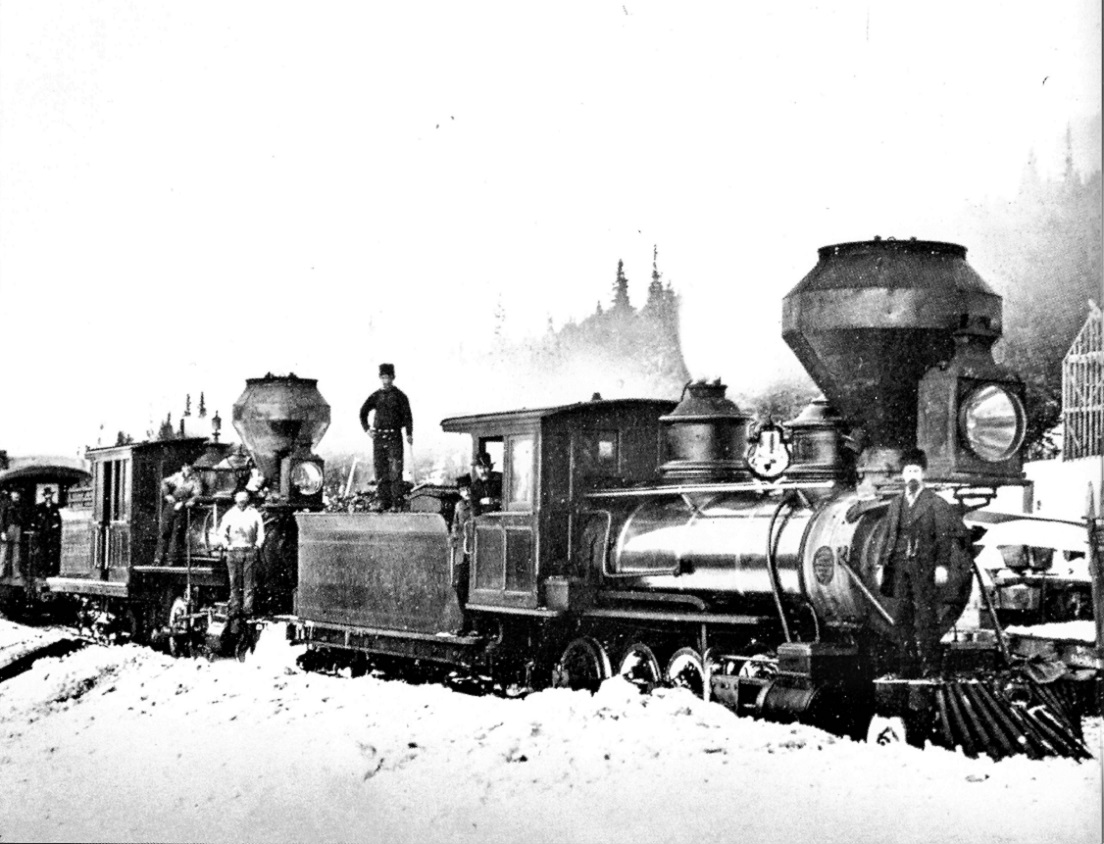 In July of 1882, when the South Park reached and began operating to Pitkin, things changed. Pitkin became the new Gunnison railhead, with a shorter, easier gap for the teamsters. Any construction materials to complete the build-out of Alpine tunnel and snow sheds could be hauled up through the tunnel and spotted at Alpine Station. The town of Hancock likely collapsed when all the tunnel workers left, and the owners of the boarding houses, eateries and bars closed their businesses and followed. Nobody bought a ticket to Hancock anymore and consigned carloads of freight likely ceased; within a few years the station agency in the depot closed and the depot itself later disappeared. The coaling platform was also removed within a few years. Functionally, Hancock became the last water stop before reaching the tunnel and had a passing siding. If there was an initial wye, it no longer saw any use, as the helpers on the short freight trains worked all the way to the tunnel in their trains, perhaps all the way to Pitkin or Nathrop. I can think of one other construction-era railhead that initially had a wye, subsequently removed—Webster, during the height of the Leadville boom: http://c-sng-discussion-forum.254.s1.nabble.com/Coal-and-Water-on-the-South-Park-td1381.html#a1399 I’ve found no written reference that there was or wasn’t a wye at Hancock prior to the first decade—it is hard to prove a negative. In Mac Poor’s book there are several “recollections” from former railroaders about freight operations over Alpine Pass. All describe three to four engine trains leaving Pitkin eastbound. Since the apex of the grade was inside the tunnel, all helper engines stayed in the train on arrival at Alpine Station. After a brake inspection / check, the four engine train would work through the tunnel, and after reaching the apex, the locomotives would prepare to brake the train as it exited the east portal, all the way down to Hancock. There the helpers were cut out, either to proceed light down to Schwanders or “turn on the Hancock wye” and return thru the tunnel to Pitkin. One “recollected” that there was never a turntable in the stone engine house or it was never used, and suggested that this was common practice over the life of tunnel operations. But—none of Poor’s published “recollections” are firmly dated. These gentlemen could be describing operations under C&S management in the latter part of the first decade, before the tunnel abandonment. It is quite possible that the C&S built/re-built a wye at Hancock, to allow this operating scenario for the heavy coal trains. So, I dunno. I think there was likely a wye at Hancock for the first few years. It may have been removed in the later 1880s as superfluous, forgotten, and then replaced 20 years later by a new management with a new operating scheme. Anyone have any other thoughts??
Jim Courtney
Poulsbo, WA |
Re: On The Way West -- Wye at Hancock??
|
This post was updated on .
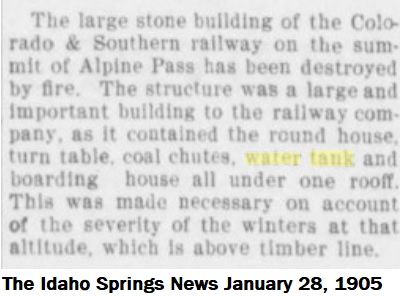 P.S. (for Dave) 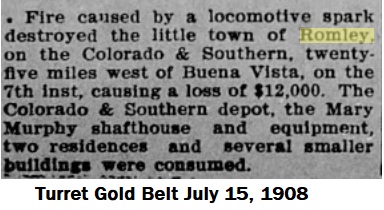
UpSideDownC
in New Zealand |
|
This post was updated on .
In reply to this post by Jim Courtney
CONTENTS DELETED
The author has deleted this message.
|
It looks like a complete wye to me, with all legs connected. The tail isn't very long, but at 110' it would be more than enough for a locomotive. The back isn't very clear in the photo due to the angle and halftone screen, but it does appear to match how it looked on the ICC map from 1918 which shows track there. The location just past the bridge even matches. This doesn't mean that the wye was there in the early years, but it does seem to be there when the photo was taken. 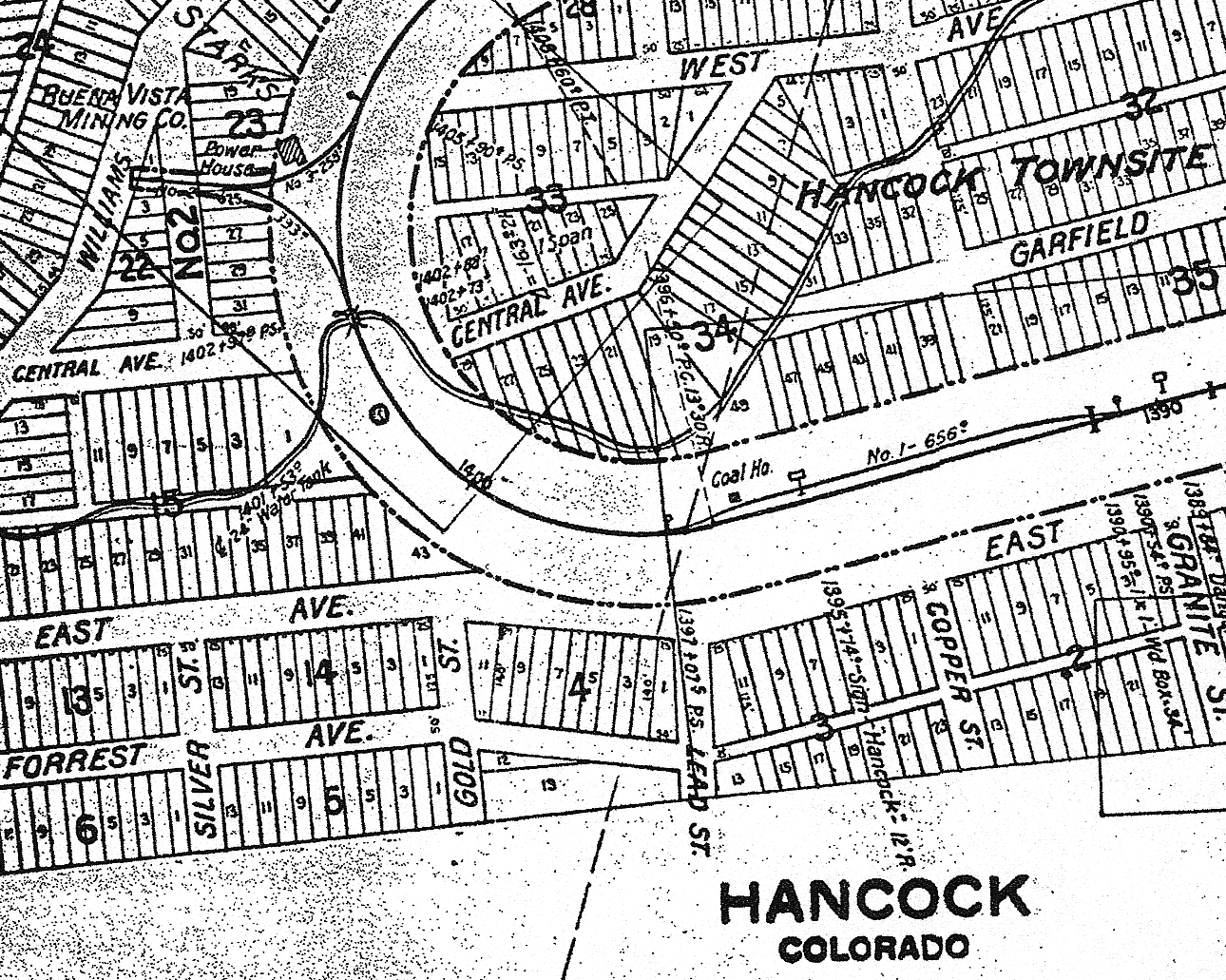 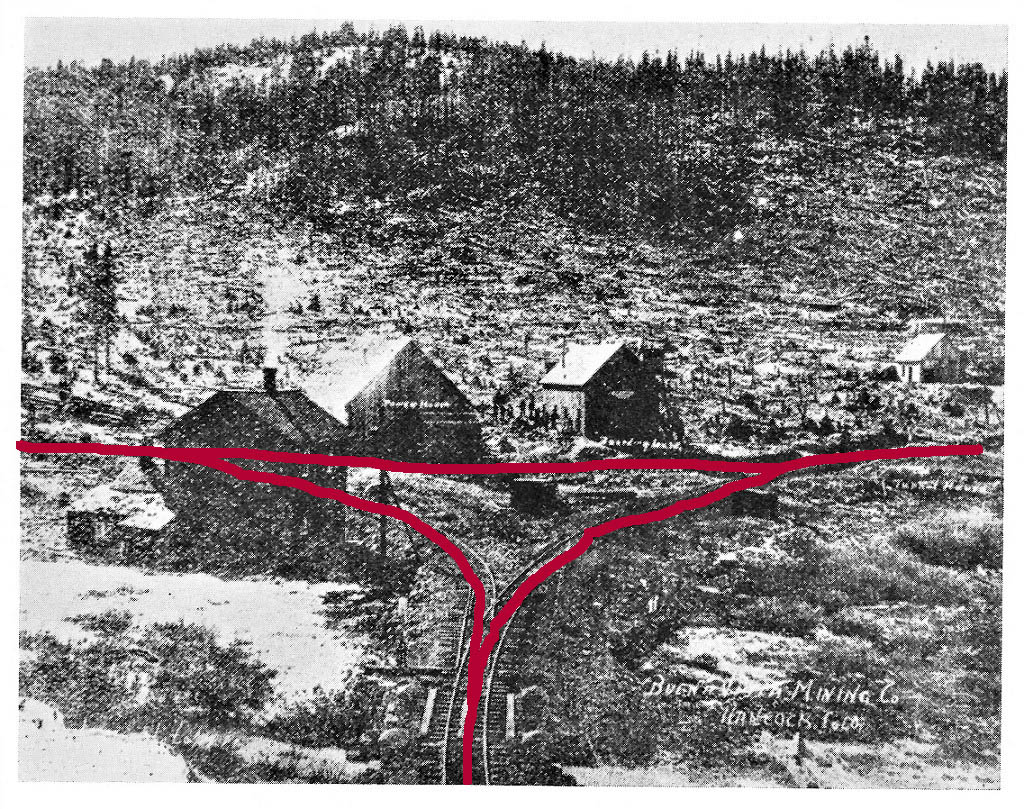
|
Re: On The Way West -- Wye at Hancock??
|
This post was updated on .
In reply to this post by Jim Courtney
Jim, thanks for you response on this question! <edit> I've found the 11/11/1883 ETT info in my notes--my Pictorial Supplement is in storage but I'd transcribed details 2 years ago</edit> I do have an October 1st, 1884, Employee's Timetable No. 5 and on it the siding length totals, water (O), coal (X) and turning facilities (Y--regardless of type) are noted. The timetable lists Y at other points on the Division: Como, Garos, Platte River, Hill Top, Buena Vista, Schwanders, Hortense, Pitkin and Gunnison. Baldwin also has a Y noted. Hancock and Alpine Tunnel are two notable locations with X and O listed, but not Y. This indicates that Hancock didn't have a wye in late 1884 OR that it wasn't in use. And this gives us no clue what things looked like prior to that time. <edit> I also have found notes on the 1898 ETT and there is no reference to a wye at Hancock at that date.</edit> By 1884, even in 1883, operations are centering on St Elmo rather than Hancock, with lots of traffic to/from Tin Cup, Aspen and Gunnison and a LOT of passengers getting off there for the various camps in the region. Westbound passenger trains (with sleeper) would end at St Elmo where passengers boarded the train to Gunnison (no sleeper apparently). Eastbound transfer at St Elmo, also. In 1885 the South Park chose St Elmo as its freight and passenger center for Aspen traffic, adding a warehouse, side tracks and turntable at that location. At the time of the turntable install one newspaper notes that the trains won't have to back to Hortense anymore. Hancock was in rapid decline by then, while Murphy's Switch was about to really boom with new expanded sidings for the various mine bins and powerhouses being added over the next two years--which resulted in Hancock station being moved in 1887 to what was now named Romley. And after a first mild winter in 1883, 1884 and most years after proved harsh with multi-month tunnel closures and St Elmo as the terminus of the line from Buena Vista, not Hancock. A wye in the early years seems very reasonable. There is nothing documented I've seen to support or deny its existence. I believe, if there was one, that it wasn't at the later location seen on the ICC map mostly because to put one in at that location in 1903 the C&S needed to excavate a grade for it into the hillside (Dan Edward's books have the document quotes for that construction). Unless the hillside slipped and covered an earlier roadbed, this feels to me that it is unlikely it was at this tight location. If there was a wye then I believe it might have been elsewhere, possibly at the other end of the sidings or even a bit east of town. Pure speculation, of course. And on turning the engines, back to that 1885 newspaper quote of the St Elmo turntable fixing the problem of engines backing down the hill. No, it isn't conclusive, but there are other examples of this on the UP system at this time such as Central City and the Greeley, Salt Lake and Pacific. It is not optimal, it seems illogical, but it was done. Skipping over the section on Hancock--no comments on that other than I have evidence the station was moved in 1887 and the coal dock was not there in 1889. Recollections are fascinating but I always take them with a grain of salt as decades-old memories can be wrong. I don't know if these particular ones are or aren't, I just keep that in mind. True of newspapers, also. It IS hard to prove a negative, especially when it's debating against a decades-old general belief. I'll say this again for the record: I'm not saying there wasn't a wye at Hancock! I know there was one after 1903 and it makes sense one was there in the very early days but I've seen no documentation supporting this early wye (please please please share if you have it!). I'm just raising the possibility because of various data points that hint there wasn't one before 1903. At least not one in the location seen on the ICC map, if at all. Did this idea a wye was always there develop out of the fact that there was one in the later days and the assumption is that it was always there? That's what I've been wondering about.
Dave Eggleston
Seattle, WA |
|
This post was updated on .
In reply to this post by Chris Walker
Hi guys,
I've waited eight months for today. My wife and I zipped up to Hancock for a picnic this morning as it's only about an hour from our house. I wanted to get some current shots of the locations in Chris's posts. Here's the first:  And the other, facing downstream toward the water tank site:  Cheers, Matt |
|
Brilliant.
Thanks Matt, your efforts highly appreciated here!  Just think, in another 8 months you could duplicate this view for us.  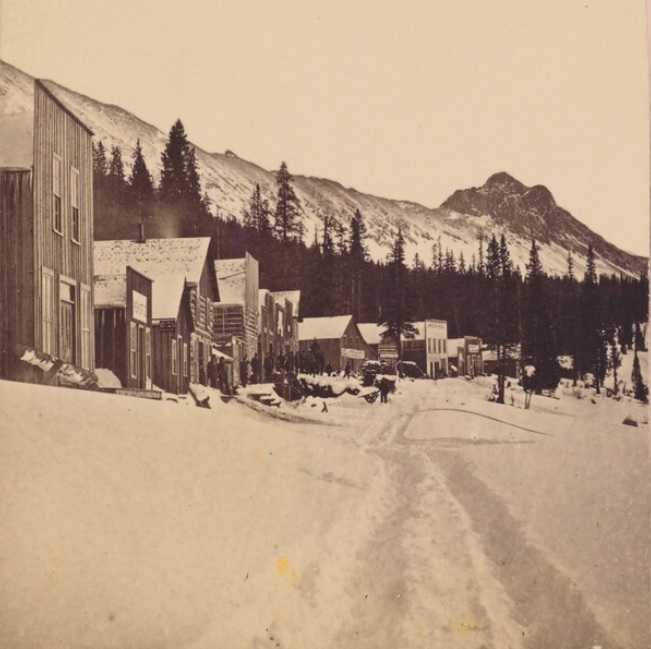
UpSideDownC
in New Zealand |
|
Well, I don't know about eight more months, but I have been up there as late as November 7th. Here's my son and a friend at the east portal November 7th, 2020:
 Cheers, Matt |
|
In reply to this post by Matt Hutson
Thanks Matt!
Great color references for Colorado high country scenery in June. Looks as I remember Hancock back in the summer of 1987 . . . has it been that long? 
Jim Courtney
Poulsbo, WA |
«
Return to C&Sng Discussion Forum
|
1 view|%1 views
| Free forum by Nabble | Edit this page |

